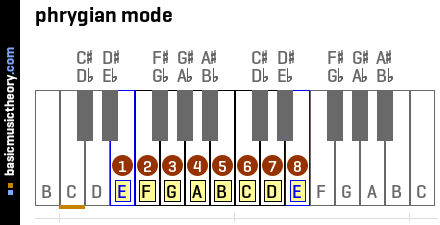Mode
| Ionian | >C | C# | Db | D | D# | Eb | E | E# | Fb | F | F# | Gb | G | G# | Ab | A | A# | Bb | B | B# | Cb |
|---|---|---|---|---|---|---|---|---|---|---|---|---|---|---|---|---|---|---|---|---|---|
| Dorian | C | C# | Db | >D | D# | Eb | E | E# | Fb | F | F# | Gb | G | G# | Ab | A | A# | Bb | B | B# | Cb |
| Phrygian | C | C# | Db | D | D# | Eb | >E | E# | Fb | F | F# | Gb | G | G# | Ab | A | A# | Bb | B | B# | Cb |
| Lydian | C | C# | Db | D | D# | Eb | E | E# | Fb | >F | F# | Gb | G | G# | Ab | A | A# | Bb | B | B# | Cb |
| Mixolydian | C | C# | Db | D | D# | Eb | E | E# | Fb | F | F# | Gb | >G | G# | Ab | A | A# | Bb | B | B# | Cb |
| Aeolian | C | C# | Db | D | D# | Eb | E | E# | Fb | F | F# | Gb | G | G# | Ab | >A | A# | Bb | B | B# | Cb |
| Locrian | C | C# | Db | D | D# | Eb | E | E# | Fb | F | F# | Gb | G | G# | Ab | A | A# | Bb | >B | B# | Cb |
Modes are similar to scales in that each mode is a set of 7 notes, with the letters C to B being used once and once only in each mode.
Below is a list of all mode names and note names in each.
| Mode name | White note names |
|---|---|
| ionian mode | C, D, E, F, G, A, B, C |
| dorian mode | D, E, F, G, A, B, C, D |
| phrygian mode | E, F, G, A, B, C, D, E |
| lydian mode | F, G, A, B, C, D, E, F |
| mixolydian mode | G, A, B, C, D, E, F, G |
| aeolian mode | A, B, C, D, E, F, G, A |
| locrian mode | B, C, D, E, F, G, A, B |
In their simplest / untransposed form, modes do not contain any sharp or flat notes.
This means that they do not contain any black notes - only the white(natural) note names of the piano are used.
This also means that since the C major scale contains no sharp or flat notes, all modes in their untransposed form are directly related to the C major scale, and can be expressed in terms of this scale.
For example, we could say that the ionian mode is the first mode (and is identical to) the C major scale.
Or we could say that the phrygian mode is the 3rd mode (ie. starts on the 3rd note, and uses all notes) of the C major scale.
The 6th mode of the C Major scale (aeolian) is interesting, since it is also identical to the A natural minor scale.
This is not surprising, since the tonic of C Major relative minor - C relative minor is calculated using the 6th note of the major scale.
Below is an example of the phrygian mode.

However, it is possible to transpose a mode to a different key, which is to take the tone-semitone pattern for a specific mode that was used to skip the black notes, and apply that pattern starting on any other note on the piano keyboard.
Once transposed, it is possible that the transposed mode might contain sharp and flat notes.
The newly transposed mode name will have the key name in front of the mode eg. G phrygian mode
For untransposed modes as shown in the table above, it is not necessary to name the key - if you use the term phrygian it is understood that this mode starts on note E.